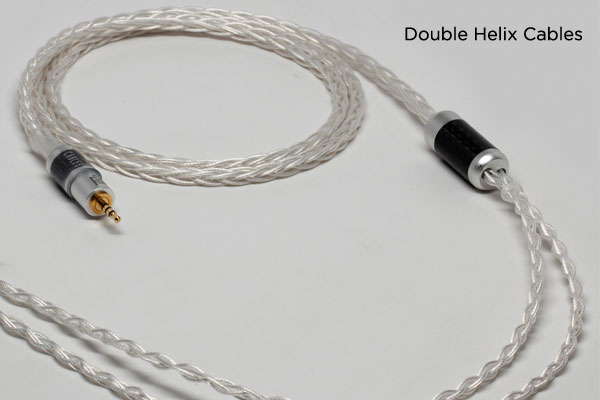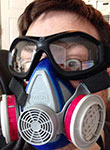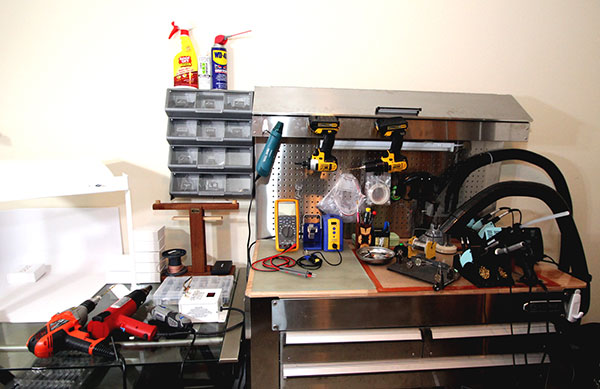The business of cables
How do you ensure you have the right setup to make cables? What’s makes a good cable office?
If you are new to cable building and plan to do it sparingly, there’s no point in buying the best hardware unless you have unlimited resources or plan to go pro. It takes trial and error to find the best equipment – for us, it simply involved buying everything and comparing it. We own the flagship Metcal, Weller, and Hakko soldering irons, and find they each have their strengths. Buy from a solid brand (especially for soldering irons) and get it right the first time unless money is very tight – and we are always happy to dispense free advice.
For us, owning the right equipment is the difference between being able to build 10 cables a day and being able to build 20 cables a day. The wrong equipment leads to inconsistent results, frustration during the build pipeline, and wasted time. As an example, I’m sure many people have tried to strip OCC litz with a regular wire stripper. You can do this, but it puts stress on the strands and with complex constructions like our Complement4 wire, it’s really not an option – you will break and nick strands. We use a thermal stripping tool – a $500 toy – which turns the insulation to butter momentarily as it slides it off safely – thanks to this, we know our cables will perform consistently and we can strip and solder wires without any wasted effort.
What is the most complex order you have ever been asked to do?
The worst ones we’ve blacked out :)
One example would be making a cable for Yamaha professional gear. We had to figure out what connectors it used, and take apart a reference cable to see how they laid it out, then come up with a braid (well, a series of sub-cables that comprise the main cable) and figure out how to shield and package it.
In terms of having a lot of steps, doing an 8 wire cable that has a remote/microphone unit built in (for smartphone use) and also a DHC aluminum y-split cover on it was real difficult. Our tiny adapters (“Ultrashort”) are a labor of love as we are attempting to build every possible adapter with the minimum of wire, or better, direct connections between the male and female ends of the adapter. Some of these adapters are more like tiny sculptures than adapters.
Our Spore cables are the most isolated headphone cables on the market, with each of the cables’ 4 signal poles having six hand applied layers of dampening & shielding. It took a lot of trial and error to build these consistently, and they are a really laborious task for us even in 2014. With the proper research and planning most cables are trivial for us to build. It’s when you are trying to do things that aren’t optimal, and you don’t have the supplies or tools that you need, that it becomes hard.
How do I know what cable matches what when I am order new headphone cables? I mean is there a better cable for a PM-1 over a HD-600?
I think there’s a little room for tuning the sound if you use one of my silver-plated copper wires – like Peptide Hybrid or Peptide Synergy (synergy is half copper, half silver plated copper litz). These wires are a little brighter than neutral but not harsh, they sound good with darker headphones like HD650 but are not necessary for HD800s. When it comes to synergy though, I don’t think there’s one cable that really does it for each headphone; things just seem to get better and better as we move up the ladder towards my top cables. I’ve never seen a headphone that doesn’t improve more with OCC silver litz than with everything else.
Do you think manufacturers pay any attention to the type of cable that they send out with their headphones? I mean the HD800 cable the Philips X1 cable, the Westone Epic cable – not the best right?
Manufacturers’ top priority is getting it mass produced for cheap, having it be compact, and having it be durable. Beyond that, all the stock cables I’ve opened up have limited thought put in them. Believe it or not, good headphone cables are not cheap and would add a lot to the bottom line for the manufacturer. The stock cables that are listed as 7N have basically no chance of actually being 7N – aside from the boutique niche company Acrolink, nobody has shown any proof that their product is 7N pure, so even the best stock cables are not worth keeping around. 7N exists in small lab quantities, not in any production lines, as basically every step of production will contaminate it.
The Oppo PM-1 cable is at least OCC copper, although it isn’t litz and will eventually oxidize. If all manufacturers start using OCC copper on their stock cable, then aftermarket cables will be a harder sell and it will come down to customizing length, ergonomics, connectivity, and fine tuning the performance, as not all OCC is created equal. IEM cables are specifically designed to be strong and flexible but nothing else; they are not made with audio-grade parts and as I mentioned before, the cadmium used in the copper alloy to strengthen it is highly toxic. For this reason I won’t work on stock IEM cables, occasionally I get requests to reterminate them.
How do you keep with up with all these new trends, plugs and technology? Do follow the trend or do you like to set the trend?
DHC spends countless all night sessions in talks with suppliers, poring through catalogs in the dark reaches of the internet, ordering samples, buying every new headphone, and putting in time at the listening station. If you buy your parts from a third party then you really don’t know what you are getting unless you can truly trust them, and you are not getting as much for your money – so practically everything DHC uses is 100% custom. A few examples – the custom black sleeving we use is not nylon, although it looks a little like the ubiquitous multifilament nylon DIYers love – it’s actually a tougher, better feeling material that is less likely to interact electrically with the polyethylene insulation that is on most of our wires. It took literally a year to get it right, and I wish that was a joke.
Copying others is anathema to us – we will only do it to solve an urgent problem. And we owe a lot to companies before us that introduced what is now basic – the concepts of braided personal audio cables, or cool wires with clear insulation. While we were second in the headphone world to adopt OCC litz (good job Norne!), we did it in part to prevent our cables from ever turning green. We don’t wait for the next big thing to happen, we are constantly plotting to bring the next cable advancement to life. The only thing that slows us down is our natural cautiousness towards bloating our product line – if I had my way, DHC would have 50 different cables. One thing I have learned is that “fortune favors the bold” – hesitating when you have an idea could mean that someone else will independently conceive the idea whether you like it or not. This has happened with one of our most popular wires – and our supplier could easily issue a press release to substantiate it – we came up with the idea out of nowhere and got quotes for the design, but waited too long to put it into production, and it came out the same month as a competitor – a bizarre coincidence.
Where do you see cable making for headphone and portable media going in the next few years? Is there a limit to this anal probing for my money by you guys?
I’ve had this discussion with Trevor @ Norne Audio – we feel like OCC litz is the end of the line. For headphones one can play around with solid and flat conductor wires and make some interesting cables (as we have) but they just aren’t durable enough to be of any further interest to DHC, although they’re not a breakage risk when used in interconnects. As long as headphones exist, we will offer what cables we feel have the most up to date wire, as everyone needs cables to connect to their favorite gear and the stock cable doesn’t work for everyone. Because of the limitations on what wireless headphones can do, I don’t think that the paradigm of headphones carrying AC audio signals through 4 conductor cables (or 8…or 16…) is going anywhere. Just like with all in one wireless speakers, they are not going to be a flagship product anytime in this century.
Portable gear will keep sounding better every year, as high resolution formats add what is basically a free SQ boost – just get the files and bam, things are sounding a little better. Each year it’ll be like the iPhone – smaller and higher performing. Who knows what the hard limit is there, but stuff like the AK240 is the future.
What is the best sounding cable out there right now if money is no object? If you could make your dream cable what would it be?
Being a very isolated cable like the DHC’s original flagship, the Spore, where each conductor basically gets a first class cabin worth of dampening & shielding, is one step. Complement4’s advancement – the “Integrated Wire” — focuses a little deeper, trying to achieve the perfect microenvironment around the copper strands themselves. There’s a central core that absorbs static electricity (turning it into heat, like a resistor) and dampens vibrations that the strand bundles wrap around. Also, there’s an industry first with Comp4 – a layer of cotton underneath the usual extruded solid wire insulation. You have the dampening/antistatic properties of cotton (which does not like to give up or accept electrons) directly surrounding the copper strands, with the same protective insulation on our polyethylene-insulated wires that maintains the integrity of the litz construct inside. With a carbon polymer shielding material on the outside in place of any heavy metal shielding, the Complement4 is a new direction for us – a more light/flexible flagship – although the Spore4 applies the full Spore shielding treatment similar to the original Spore design, but with our most up to date wire at its core.
Having OCC silver over OCC copper simply adds more detail. OCC copper is a superior value, but silver is the most conductive metal on the planet — and it’s incredibly sad how many people are afraid of it because they think it will be bright and harsh – to where customers move in the wrong direction when it comes to wire composition, to get away from it. But I’ve never once been told my OCC silver is harsh – it’s just a better sounding version of copper all-around.
So… Complement4/Spore4 with OCC silver – it’ll be here before you know it – will be 22awg litz OCC silver which is the “premium” size of wire – not too big, not at all small, and at the limits of what an IEM cable or a USB cable can really use. With the improvements we’re working on, it ought to work for practically all audio applications, and here is the bottom line:
If I had a million dollars to spend on cabling a top notch setup, and I’d take a lie detector test to attest to this – in my mind there wouldn’t be a better cable I could purchase. Maybe in 5 years I’ll think up a way to improve it, but for now, this is it.
How do you wish to be remembered Peter? If things all stopped on what note should it stop?
It sounds lame, but it’s the truth – while this is a business, I’ve made a ton of good friends doing this job. People have more fun with their stereos and headphone rigs thanks to DHC’s work. With a great product, you’re going to spend more time getting into the music – with a lot of audio gear over the years, it’s sat around my office, until I got my AK240, which was just so much fun to use along with some newly-built balanced cables. I really made more time for music listening alongside the endless hours of work. Good music is exhilarating and while you don’t need high end cables to enjoy it, this is a hobby where the experience scales up and up, and part of the fun is indeed hearing more and more of the detail hidden in your favorite recordings.
As I push towards the perfect wire, I already know the next flagship cable I build is going to be an entirely new experience not just for my customers, but for me as well. In developing these cables there’s always regrets along the way, that you didn’t do something sooner or you spent so long with the wrong materials – it feels in retrospect that you were in the dark. The mark of a great company is working quickly, cutting your losses, and finding the perfect cable before everyone else does. Now that I’ve tried so many endless combinations, I’m satisfied that our favorite wire, OCC litz, is the future, and the technology that others will look back at and wish they had employed from day one.
Time for a rest, yes?.. NO?
And with that I rested and Peter, uhmmm went onto do a million other things. Wow, I thought I drank too much coffee but Peter seems to have a whole farm of it by the looks of the energy he has. I do not think he sleeps, I think he pays someone else to sleep and eat for him. I have never seen a guy so ‘on the money’ for his trade. Personally I think I just got my ass handed to me on a plate regarding cables and the world of headphones. I am sure I can think of a few more memes to describe speaking and listening to what Peter has to say and if it not for the fact I have a limited space on my server I think this interview would just go on and on. It is one of the few things I actually look forward too apart from my regular sessions of Candy Crush and updating the Headfonics FB page – “What is Peter working on today?” Might be a better eulogy to say what is Peter working on this minute!
Links: http://www.doublehelixcables.com/store/
Contact Details
Double Helix can be reached via email/Google Talk at doublehelixcables@gmail.com
Call them with Google Voice. Just dial: (405) 928-8DHC







